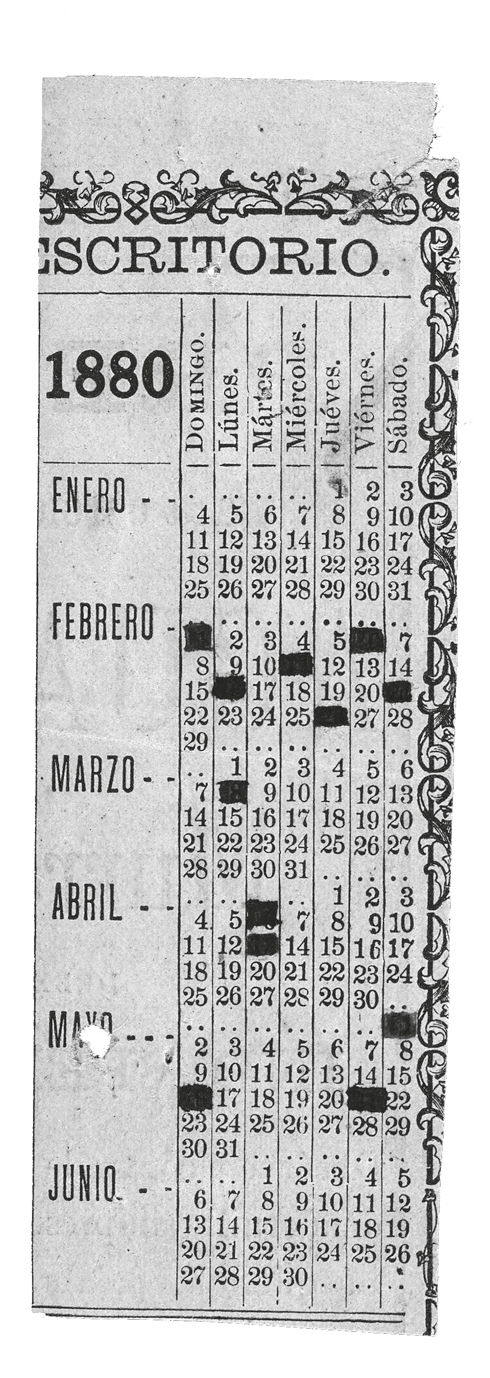From William Nation 22 September 1881
Lima,
September 22, 1881.
Dear Sir,
On the enclosed paper, I have marked down, in the order they were laid, the eggs of a pair of tame Cow-birds.1
Being acquainted with the “instincts” of the Molothrus, from the writings of Wilson and yourself, I was highly pleased to find, on my arrival, (1850 the eggs and young of a “parasite” in the vicinity of Lima.2
I left Lima for the interior, but on my return in 1860, I commenced to collect and rear a great many of these birds.
It would afford me great pleasure (and I am greatly disappointed in not being able to do so) to speak you of the facts, of this and other Peruvian birds, which I have collected under the guidance of your writings; to thank you for the many pleasant hours you have given me in showing me the mysteries of nature.
The facts which I have collected may be briefly stated as follows:— The Purple Cow-bird—(Molothrus purpurascens) is a nearly allied form of M. sericeus; and ranks among the most beautiful birds of Peru.3 It is a resident species in Western Peru. It is (especially the female) a very shy and timid bird. It lays its eggs in the nests of the Sparrow (Zonotrichia peliata), Starling (Sturnella bellicosa), and, Pipit (Anthus chii) only.4 The eggs of the Sparrow (in size and colour) are very much like the eggs of the Molothrus, the eggs of the Starling are larger and somewhat different in colour, but the eggs of the Pipit are very different both in size and colour. Generally one egg of the Molothrus is found in a nest; but I have found as many as six. The young Molothrus does not always eject its foster-brothers; I have seen a young Molothrus nearly fully feathered in a nest with two young Starlings. I have also found two young of the Molothrus nearly fully feathered in the nest of a starling, but in this instance, the young starlings had been ejected from the nest.
The pair of Molothrus whose eggs I have marked down, are six years old. The female began to lay when she was two years old; and has laid, the number of eggs on the paper, every year.
It is remarkable that the six first eggs are laid at intervals of four days. This no doubt is the number of eggs which the progenitor of the Molothrus used to lay when it made its nest. The other six eggs belong to the second nest. A near ally of the Molothrus (Icterus) lays six eggs.5
I find that the Sturnella always lay three eggs. In the nest—without exception—two birds are females. In the Genus Molothrus it is the reverse. of three young birds I have invariably found two of them to be males.
The seed enclosed was taken from the stomach of a bird shot in the Andes near the Rimac. It is a Chilean bird and I have ascertained that it migrates every year to Peru. The seed is a Lupinus.6
I believe birds play a greater part in the distribution of plants than it is even supposed. I have no space to give a list of Peruvian birds in which I have found seed, or the names of plants which these birds eat.
I am Dear Sir, | Your very truly | William Nation
Dr. Darwin | &c &c
[Enclosure]

Footnotes
Bibliography
Birds: Pt 3 of The zoology of the voyage of H.M.S. Beagle. By John Gould. Edited and superintended by Charles Darwin. London: Smith, Elder and Co. 1839–41.
Journal of researches (1860): Journal of researches into the natural history and geology of the countries visited during the voyage of HMS Beagle around the world, under the command of Capt. FitzRoy RN. By Charles Darwin. Reprint edition. London: John Murray. 1860.
Wilson, Alexander. 1808–14. American ornithology: or, The natural history of the birds of the United States. 9 vols. Philadelphia: Bradford and Inskeep.
Summary
Reports on the behaviour of the Peruvian cow bird, Molothrus, which lays its eggs in other birds’ nests.
Letter details
- Letter no.
- DCP-LETT-13350
- From
- William Nation
- To
- Charles Robert Darwin
- Sent from
- Lima
- Source of text
- DAR 172: 5
- Physical description
- ALS 5pp, encl 1p
Please cite as
Darwin Correspondence Project, “Letter no. 13350,” accessed on 19 April 2024, https://www.darwinproject.ac.uk/letter/?docId=letters/DCP-LETT-13350.xml


